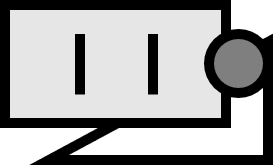Euclidean Axioms System
Overview 1
Euclid presented 23 definitions, 5 postulates, and 5 common notions in his work Elements of Geometry.
Axioms
The definitions are arranged slightly differently from the original text because they in fact mix items that are closer to “rules” rather than strictly defining 23 separate concepts. For example, “(3) The ends of a line are points” is closer to an additional remark about a line than a formal definition.
Definitions
(1) That which has no part is called a point.
Line
(2) That which has length only, without breadth, is called a line. (3) The ends of a line are points. (4) A line which lies evenly with the points on it is called a straight line.
Surface
(5) That which has length and breadth is called a surface. (6) The end of a surface is a line. (7) A surface which lies evenly with the straight lines on it is called a plane surface.
Angles
(8) When two straight lines meet and are not in the same straight line, the inclination of one to the other is called a plane angle. (9) When the lines containing an angle are straight, the angle is called a rectilinear angle. (10) If the adjacent angles made by two straight lines are equal, each of the equal angles is called a right angle, and a straight line is said to be perpendicular to another. (11) An angle greater than a right angle is called an obtuse angle. (12) An angle less than a right angle is called an acute angle.
Figures
(13) The extremities of anything are called its boundary. (14) That which is contained by a boundary is called a figure.
Circles
(15) A circumference is a line the points of which are all at the same distance from a certain point; the plane figure contained by such a circumference is called a circle. (16) That point is called the center. (17) A straight line drawn through the center and terminated both ways at the circumference is called a diameter; it bisects the circle. (18) A semicircle is the figure contained by a diameter and the arc cut off by the diameter.
Polygons
(19) A figure contained by straight lines is called a rectilinear figure. If it is contained by three straight lines it is a trilateral figure, by four a quadrilateral figure, and by more than four a multilateral figure.
- From now on these will be called triangles, quadrilaterals, and polygons.
(20) If all the sides of a triangle are equal it is called an equilateral triangle, if two sides are equal an isosceles triangle, and if all three sides are unequal a scalene triangle. (21) A triangle with a right angle is a right-angled triangle, with an obtuse angle an obtuse-angled triangle, and with three acute angles an acute-angled triangle.
(22) A quadrilateral with four equal angles and equal side lengths is a square; if all four angles are right angles but side lengths differ, it is a rectangle; if the side lengths are equal but angles are not right angles, it is a rhombus; if opposite angles are equal, it is a rhomboid (parallelogram).
Parallel lines
(23) Straight lines which, being in the same plane and produced indefinitely in both directions, do not meet are called parallel lines.
Postulates
- A straight line may be drawn from any point to any point.
- A produced straight line can be extended indefinitely.
- A circle may be described from any center with any radius.
- All right angles are equal to one another.
- If a straight line falling on two straight lines makes the interior angles on the same side less than two right angles, then the two straight lines, if produced indefinitely, meet on that side on which the angles are less than two right angles.
Common notions
- Things which are equal to the same thing are equal to one another.
- If equals are added to equals, the wholes are equal.
- If equals are subtracted from equals, the remainders are equal.
- Things which coincide with one another are equal to one another.
- The whole is greater than the part.
Remarks
This should be taken only as a reference. Today some terms (for example, what used to be called a “line segment”) may be used differently, and from a modern perspective some statements may be incorrect or not rigorous. For example, “the whole is greater than the part” is more properly expressed as “the whole is greater than or equal to the part.” Such minor irritations can generally be overlooked.
Non-Euclidean geometry
The fifth postulate is also known as Playfair’s axiom.
Playfair’s axiom: Given a straight line $l$ and a point $p$ not on it, there exists exactly one straight line $m$ which passes through $p$ and is parallel to $l$ 2.
From Euclid’s time for nearly 2,000 years mathematicians questioned this postulate and attempted to derive it from other postulates — to question a postulate meant suspecting that it could be stated as a theorem instead. The turning point in this controversy came in the 17th century with Saccheri, a forerunner of non-Euclidean geometry, who, by denying the postulate, was able to prove results that appeared quite paradoxical to mathematicians rooted in Euclidean geometry.

As an intuitive example, Playfair’s axiom is necessary as a postulate on the plane but, as in the figure above, it may fail on certain curved surfaces.
See also
Fitzpatrick, R. (2008). Euclid’s elements of geometry. https://farside.ph.utexas.edu/Books/Euclid/Elements.pdf p6. ↩︎
Fitzpatrick, R. (2008). Euclid’s elements of geometry. https://farside.ph.utexas.edu/Books/Euclid/Elements.pdf p13. ↩︎
